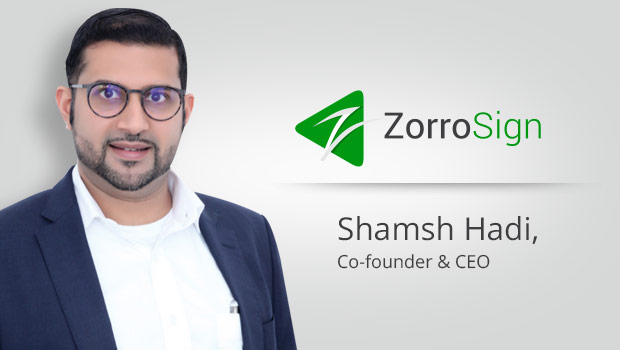- Published on
Top Five Most Important Questions to ask Before Choosing an eSign Solution
- Authors
-
-
- Name
- Michael Jones
-

An interview with Shamsh Hadi, a co-founder and CEO of ZorroSign.
Since the mid 1990’s when electronic signature was first invented by one of ZorroSign’s Co-Founders, global commerce has experienced a rapid digital transformation. Businesses soon began to realize that in order to compete on a global scale, implementing processes that allowed for paperless (digital) transactions was imperative for growth. As a result, companies started adopting eSignature solutions.
Almost two decades after eSignature became legally recognized through the passage of the ESIGN Act of 2000, many companies are still slow to adopt this transformative technology. ZorroSign has taken the eSignature technology into its next phase of evolution; Digital Transaction Management (DTM) and digital document security. Today, ZorroSign customers are not only using electronic signatures to execute contracts, but they are managing entire business processes using workflow automation. There are several products in the market today that don’t necessary fulfill the promise of DTM. Shamsh Hadi, Co-Founder and CEO of ZorroSign explains the five questions he feels are most important for business leaders to ask before choosing an eSignature and DTM solution.
1. What is DTM and how different is it from eSignature?
Digital Transactions Management (DTM) refers to a software system that enables organizations to digitally manage document-based business transactions. From simple business transactions like non-disclosure agreements and sales contracts to more complex ones such as new hire packet handling and purchase order processing. ZorroSign customers are managing diagnostic lab workflows, M&A transactions, and real estate deals. A true DTM platform is more than just eSignatures, it also includes verification and authentication, non-repudiation, automation engine, workflow management, and multiple levels of security and privacy controls. There are levels of DTM, from basic to more complex enterprise systems. An advanced DTM solution can include a document management system, rules and policy engine, adherence and compliance to various laws and regulations such as Sarbanes-Oxley, GDPR, Document Retention Policies, and intelligent forms management. There are also provisions for security, privacy, authenticity, legality, and trust for managing document-based transactions conducted on all types of devices used.
In contrast, eSignature is one, but very important, component of a DTM system and refers to “any electronic indication of intent to agree to a record.” eSignature has its own set of characteristics, features, and use cases. Customers get the advantage of signing a document using a verbal signature, like giving consent over the phone, with a simple click on a checkbox or any electronically signed authorization. The four main components of a valid eSignature are: Method of signing, Data Authentication, User Authentication and the ability of the eSignature to capture the intent to eSign.
2. What can I use eSignature and DTM solution for?
eSignature and DTM are key to digital transformation for any organization. The grand promise of DTM is that it eliminates physical paper from the office and offers highly secure way to execute business transactions. Specifically, a DTM system can be used to automate business transactions from contracts execution to approval processes, managing digital records, capturing electronic and biometric signatures to secure sensitive documents, content automation, and support for mobile devices. More sophisticated solutions offer protection of documents or digital assets. All industries benefit from adopting an eSignature and a DTM solution, and each industry has its own blend of use cases and applications to use DTM system for. What DTM is to business transactions; CRM is to contact management.
3. How are eSigned documents legally binding and admissible in court?
The US Federal ESIGN Act of 2000 made electronic signatures and eSigned documents legally binding and admissible in court if they meet specific qualifications and constitute, “an electronic sound, symbol, or process, attached to or logically associated with a contract or other record and executed or adopted by a person with the intent to sign the record.” Further, the Uniform Electronic Transactions Act (UETA) provides additional guidance on the validity of eSignatures and how to ensure they are legally binding. In the case of ZorroSign, we go beyond the legal parameters and offer added features to ensure authentication and verification of users, documents, and processes.
4. Is pasting an image of a signature on a document same as eSigning a document?
No, what we call, superimposing an image of a signature on a document is not the same as eSigning a document. In short, a legally binding electronic signature must meet specific criteria where the intent to enter into a contract is clear and verifiable and can be traced back to the person who the signature belongs to. Furthermore, a simple image can be simply cut out of a document and replaced with something else. That’s why only real electronic signatures are legally binding and admissible in court.
5. Are my eSigned documents secure against document fraud?
With ZorroSign, they are. ZorroSign has a proprietary technology, called Zorrosign 4n6 (Forensics) Token, that helps detect post-execution document fraud and signature forgery. ZorroSign 4n6 encrypted Token is the multipurpose bridge which comprehensively validates both electronic and paper documents. 4n6 Token can help verify that a document has not been tampered, revised, revoked, replaced or canceled. By adopting Zorrosign 4n6 (Forensics) Token Technology in their document transaction process, businesses can have the peace of mind that their documents are secure and always verifiable.
Zorrosign 4n6 Token, when challenged or investigated, can be used as evidence without repudiation in a court of law. Users can view audit trail including attachments, signatories, biometrics, time stamp, among many other pieces of information about the users, the documents and process used. Thus, you will never have any trouble with online document verification whenever required.
Contact ZorroSign if you are curious and interested to learn more about eSignature, document fraud, and DTM.